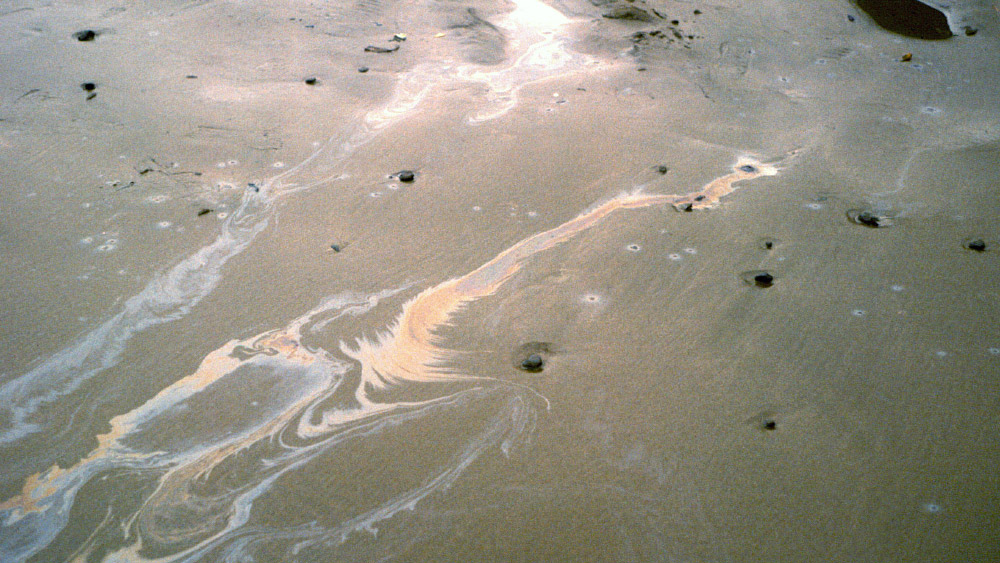Water Quality
Olympic Coast

Why is it a concern?
Water quality can be degraded by the presence of chemical contaminants (pesticides, hydrocarbons or oil, heavy metals), pathogens, excessive sedimentation, and elevated nutrient loads. By these conventional measures, marine water quality within Olympic Coast National Marine Sanctuary (OCNMS) is not notably compromised. There are no point sources of pollution in the vicinity, such as sewage outfalls or industrial discharge sites, or large centers of human development to degrade water conditions.
Spills are a potential source of contaminants in sanctuary waters. Washington state is one of the nation's primary petroleum refining centers. Tank vessels and barges containing crude oil and refined products transit in or near the sanctuary to and from Washington's refineries. This risk is changing as exports of different petroleum products, heavy crude from Canada and lighter crude from the Dakotas, are increasing. Moreover, commercial ships in transit to and from major port facilities in Washington and British Columbia hold significant quantities of fuel. Most commercial ship traffic in the region occurs within or adjacent to sanctuary waters. Oil contamination of marine mammals and seabirds can cause eye irritation, impairment of thermal regulation, loss of buoyancy, direct toxicity, reproductive abnormalities, and ultimately death. Sea otters and many species of seabirds that inhabit or use the ocean's surface are particularly susceptible to damage from oil in coastal waters. Oil spills can deplete food sources and damage habitat characteristics essential for survival of plants and animals. A catastrophic spill could wipe out at one generation of a population, and in a worst-case scenario, severely deplete multiple species on a local or regional scale.
In 2009, OCNMS and partners published results of a comprehensive investigation of pathogens and contaminants in Washington's sea otters, a high trophic level, keystone species in the sanctuary. A high percentage of the otters tested positive for exposure to pathogens, some of which have caused mortality in sea otters in California. Sea otter tissues had trace levels of chemical contaminants, not high enough to raise concerns. Other marine mammals, particularly killer whales from the Southern Resident population, contain high contaminant burdens that have been linked to health and reproductive problems.
Overview of Research
Research conducted by sanctuary scientists and partners provides critical information to address existing and emerging resource conservation and management issues. The Overview of Research highlights some, but not necessarily all, of the research activities completed or ongoing at the sanctuary.
| Project Name | PI and contacts | Links |
|---|---|---|
Sea Otter Contaminant Study |
OCNMS, USFWS, and others |
http://sanctuaries.noaa.gov/science/conservation/brancato.html |
NOAA Status and Trends/Mussel Watch |
http://ccma.nos.noaa.gov/about/coast/nsandt/musselwatch.aspx |
|
Southern Resident Killer Whales |
NOAA Northwest Fisheries Science Center |
http://www.nwfsc.noaa.gov/news/features/killer_whale_report/index.cfm |
Science Needs and Questions
The best available science is used by Sanctuary scientists and managers working to address priority resource conservation and management issues. As priorities change and new issues emerge, each Sanctuary develops new science needs and questions and works with partners to address them.
- Are concentrations of chemical contaminants in waters, sediments and biological resources changing?
- Are contaminants present or accumulated at levels that may cause impacts to living organisms?
- Do ongoing or proposed human activities contribute contaminants not previously identified?
- At what frequency should marine habitats and organisms be monitored for chemical contamination, and which are the key parameters of interest?
Education and Outreach Material
Please refer to the Olympic Coast National Marine Sanctuary website to learn more about education and outreach materials
Olympic Coast Oil Spill Simulation: An Introduction to Geospatial Analysis through Google Earth
References
Lanksbury, J. and J.E. West. 2012. 2011/2012 Mussel Watch Phase 1 Sampling Summary and Progress Report. Washington Department of Fish and Wildlife. 75pp.
WDOE (Washington State Department of Ecology). 2007. Oil spills in Washington State: a historical analysis. Publication number 97-252. Revised March 2007. Olympia, Washington.
Brancato, M.S., L. Milonas, C.E. Bowlby, R. Jameson and J.W. Davis. 2009. Chemical contaminants, pathogen exposure and general health status of live ad beach-cast Washington sea otters (Enhydra lutris kenyoni). Marine Sanctuaries Conservation Series. ONMS-09-01. 181 pp.

